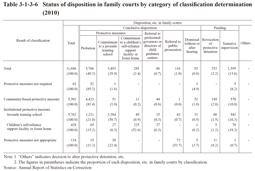2 Classification activities
(1) Institutional classifications
Fig. 3-1-3-5 shows the standard flow of classifications of juveniles for whom a decision to place them in protective detention (commitment to a juvenile classification home) was made (institutional classification). Whether to use a community-based protective measure (probation, etc.) or institutional protective measure (commitment to a juvenile training school, etc.) with a juvenile is determined (classification determination) based on the results of classification interviews, psychological tests, behavioral observations, and medical diagnosis, as well as external information. The result of the classification is then recorded in a report along with the characteristics of the juvenile’s predisposition, factors that may have led them into delinquency, and guidelines for use in their reformation/rehabilitation, which is then made available to the family court as data for use in the hearing. If a disposition of protective measures is decided upon, the result of the classification is also sent to the juvenile training school or probation office for use as reference material in the juvenile’s subsequent treatment.
Fig. 3-1-3-5 Flow of institutional classification in juvenile classification homes
Table 3-1-3-6 shows the relationship between the classification determination and disposition in family courts, etc. of juveniles whose classification determination was completed (only those placed under protective detention were totaled for the year of their discharge) in 2010.
Table 3-1-3-6 Status of disposition in family courts by category of classification determination (2010)
(2) Non-institutional classifications
a. Classifications at the request of a family court without physical restraint
Although institutional classifications take place in most cases dealt with by family courts, classifications can also take place by summoning juveniles to a family court or juvenile classification home, etc. without physical restraint. In 2010, 220 juveniles received classifications without physical restraint (Source: Annual Report of Statistics on Correction).
b. Classification at the request of the relevant Ministry of Justice agency
The number of persons received for classification at the request of a relevant Ministry of Justice agency in 2010 was five from public prosecutors offices, 4,199 from juvenile training schools or penal institutions, and 5,430 from Regional Parole Boards or probation offices (Source: Annual Report of Statistics on Correction).
The classification activities that took place in response to requests include classification of the subjects’ predisposition, individual or group psychological tests, and interviews and enquiries, etc. to formulate or change the treatment plans for them.
c. Classification services for the general public
Classification services can take place upon request from the general public or public/private organizations, etc. The content of those consultations can be rather wide-ranging and can include not only delinquency but also juveniles’ characters, discipline, and any necessary student guidance, etc.

